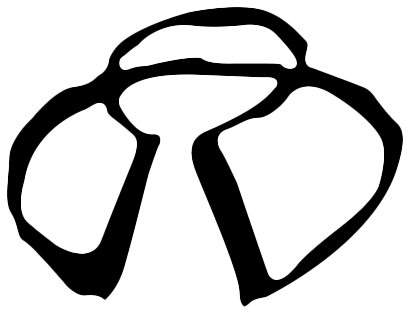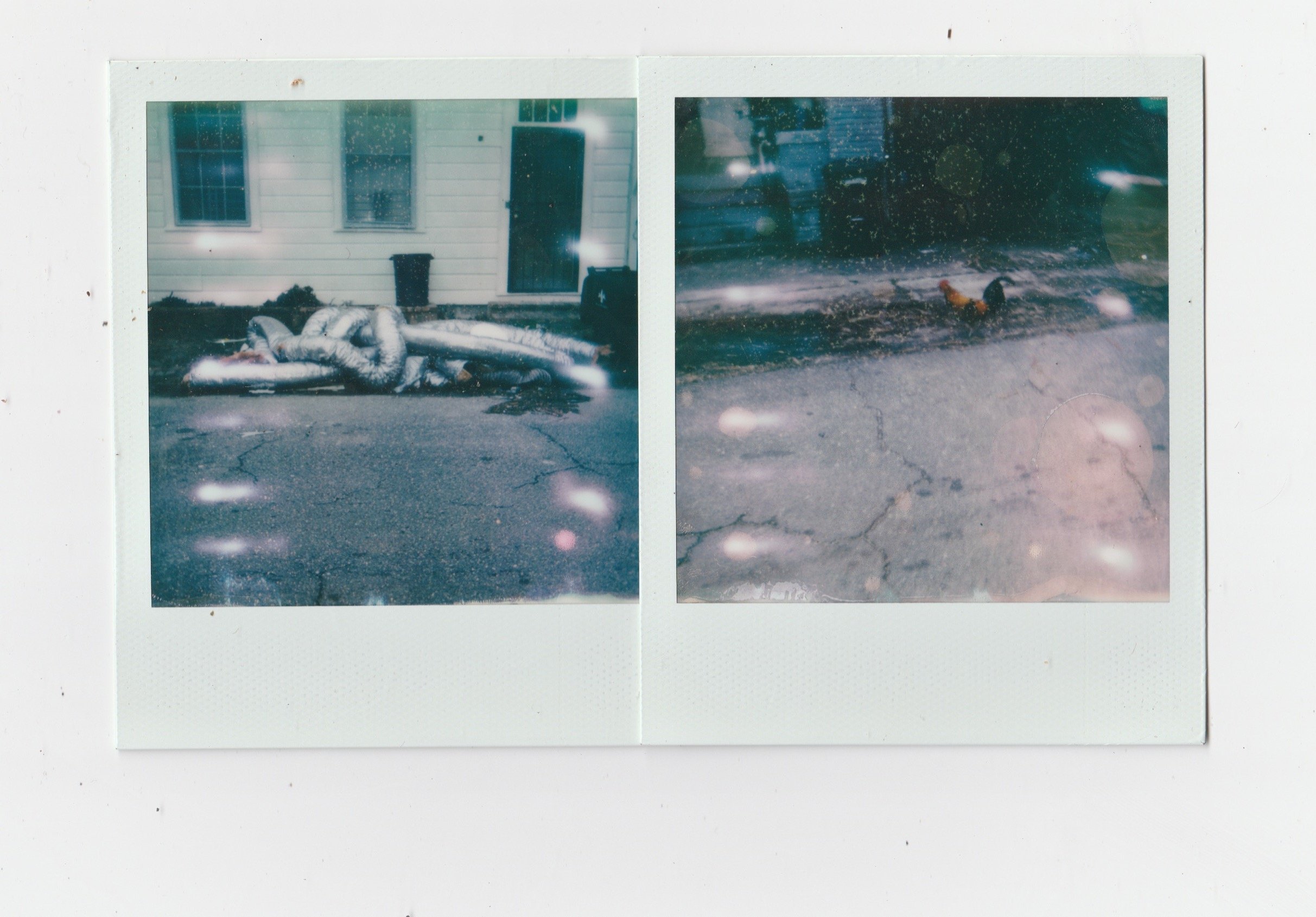Rosalie Smith "Chrome tube, // pink inside, // cock approaching"
2021 , two Polaroids mounted on 14 x 11” mat board, $210
drawer 4
Artist statement
My work analyzes the tension between the natural world and the built environment as a site of grief. Recently I have been exploring the poetics of objects that signify elements of life cycles beyond death, while attempting to retain an awareness of the tenuousness of life. In these landscapes formed by two Polaroids, I create sexual innuendo. I like the Polaroids for their instant translation of the subject into an object. I work with an old family camera that distorts the images in the process of developing them, inserting my perspective and lived experience as a filter that literally distorts my subjects. I have been opposed to using my own body or any subjugated body in my work due to a belief that all forms of representation are inherently flattening and thus harmful. In spite of this, I have felt a strong desire to incorporate my body in my work and it feels somewhat freeing to break this rule and use it in Max’s hole, // trunk, //and two rubber tires. In a way, I am realizing my body as my own scale of permanence. I like the idea of the photograph outliving the body itself.
Artist bio
I am an artist and poet born in Blacksburg VA., 1993. I moved 11 times before I was 18, some of which was spent in Upstate New York and New Orleans. I studied art and landscape studies at Smith College. I moved back to New Orleans after graduating and worked at the Contemporary Arts Center as a grant writer until my mother was diagnosed with cancer. I left my position to help care for her, and began committing time to my artistic practice again. I was included in the first significant shows of my career the same month she died, August 2018, one opening the night of her death. During April of 2020, I took long walks in New Orleans. I saw rubber medical gloves accumulate in gutters, vacant lots, and the neutral ground. I collected them, recognizing them as a kindred material to my larger body of work--filthy, worn, a futile attempt at protection. I began using thin coats of resin to cast the gloves into organic forms, as featured in "Water Hyacinth." My practice has often resulted in personal monuments to human experiences, made accessible through formal abstraction. My Mother’s Last Garden is an installation made with flowers collected from bouquets sent to my mother when diagnosed with terminal cancer. In an effort towards preservation, I coated the flowers in resin and planted them in cement. In this installation I evoke the solitary yet universal nature of grief. The process reflects a struggle to preserve the already dead flowers. It was recently written about in Art In America, after being shown at the Contemporary Arts Center in New Orleans, where it moved strangers to tears.
2021 , two Polaroids mounted on 14 x 11” mat board, $210
drawer 4
Artist statement
My work analyzes the tension between the natural world and the built environment as a site of grief. Recently I have been exploring the poetics of objects that signify elements of life cycles beyond death, while attempting to retain an awareness of the tenuousness of life. In these landscapes formed by two Polaroids, I create sexual innuendo. I like the Polaroids for their instant translation of the subject into an object. I work with an old family camera that distorts the images in the process of developing them, inserting my perspective and lived experience as a filter that literally distorts my subjects. I have been opposed to using my own body or any subjugated body in my work due to a belief that all forms of representation are inherently flattening and thus harmful. In spite of this, I have felt a strong desire to incorporate my body in my work and it feels somewhat freeing to break this rule and use it in Max’s hole, // trunk, //and two rubber tires. In a way, I am realizing my body as my own scale of permanence. I like the idea of the photograph outliving the body itself.
Artist bio
I am an artist and poet born in Blacksburg VA., 1993. I moved 11 times before I was 18, some of which was spent in Upstate New York and New Orleans. I studied art and landscape studies at Smith College. I moved back to New Orleans after graduating and worked at the Contemporary Arts Center as a grant writer until my mother was diagnosed with cancer. I left my position to help care for her, and began committing time to my artistic practice again. I was included in the first significant shows of my career the same month she died, August 2018, one opening the night of her death. During April of 2020, I took long walks in New Orleans. I saw rubber medical gloves accumulate in gutters, vacant lots, and the neutral ground. I collected them, recognizing them as a kindred material to my larger body of work--filthy, worn, a futile attempt at protection. I began using thin coats of resin to cast the gloves into organic forms, as featured in "Water Hyacinth." My practice has often resulted in personal monuments to human experiences, made accessible through formal abstraction. My Mother’s Last Garden is an installation made with flowers collected from bouquets sent to my mother when diagnosed with terminal cancer. In an effort towards preservation, I coated the flowers in resin and planted them in cement. In this installation I evoke the solitary yet universal nature of grief. The process reflects a struggle to preserve the already dead flowers. It was recently written about in Art In America, after being shown at the Contemporary Arts Center in New Orleans, where it moved strangers to tears.
2021 , two Polaroids mounted on 14 x 11” mat board, $210
drawer 4
Artist statement
My work analyzes the tension between the natural world and the built environment as a site of grief. Recently I have been exploring the poetics of objects that signify elements of life cycles beyond death, while attempting to retain an awareness of the tenuousness of life. In these landscapes formed by two Polaroids, I create sexual innuendo. I like the Polaroids for their instant translation of the subject into an object. I work with an old family camera that distorts the images in the process of developing them, inserting my perspective and lived experience as a filter that literally distorts my subjects. I have been opposed to using my own body or any subjugated body in my work due to a belief that all forms of representation are inherently flattening and thus harmful. In spite of this, I have felt a strong desire to incorporate my body in my work and it feels somewhat freeing to break this rule and use it in Max’s hole, // trunk, //and two rubber tires. In a way, I am realizing my body as my own scale of permanence. I like the idea of the photograph outliving the body itself.
Artist bio
I am an artist and poet born in Blacksburg VA., 1993. I moved 11 times before I was 18, some of which was spent in Upstate New York and New Orleans. I studied art and landscape studies at Smith College. I moved back to New Orleans after graduating and worked at the Contemporary Arts Center as a grant writer until my mother was diagnosed with cancer. I left my position to help care for her, and began committing time to my artistic practice again. I was included in the first significant shows of my career the same month she died, August 2018, one opening the night of her death. During April of 2020, I took long walks in New Orleans. I saw rubber medical gloves accumulate in gutters, vacant lots, and the neutral ground. I collected them, recognizing them as a kindred material to my larger body of work--filthy, worn, a futile attempt at protection. I began using thin coats of resin to cast the gloves into organic forms, as featured in "Water Hyacinth." My practice has often resulted in personal monuments to human experiences, made accessible through formal abstraction. My Mother’s Last Garden is an installation made with flowers collected from bouquets sent to my mother when diagnosed with terminal cancer. In an effort towards preservation, I coated the flowers in resin and planted them in cement. In this installation I evoke the solitary yet universal nature of grief. The process reflects a struggle to preserve the already dead flowers. It was recently written about in Art In America, after being shown at the Contemporary Arts Center in New Orleans, where it moved strangers to tears.

